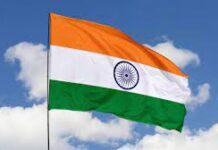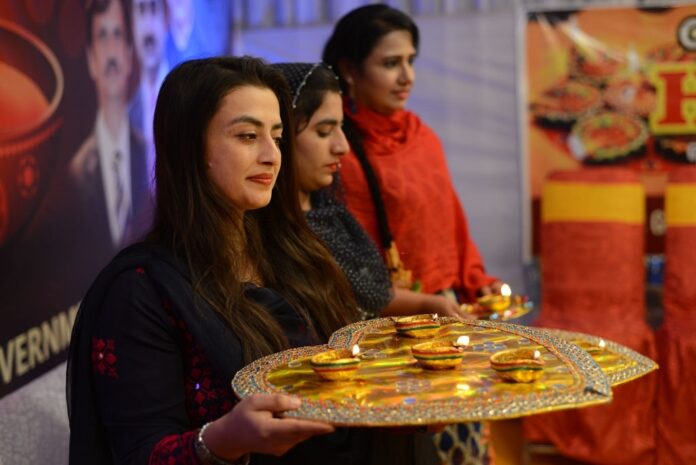KARACHI: A Pakistan-based think tank has debunked reports by several international and domestic non-governmental organisations (NGOs) claiming girls from the minority Hindu community are being forced to convert to Islam in the country, mainly in Sindh.
“There is no evidence suggesting that non-Muslims, including underage girls, have been forcibly converted to Islam in Sindh,” said the study by the Islamabad-based Institute of Policy Studies (IPS).
The “largest long-term” study, the IPS said, is based on the 10-year episodic fieldwork, interviews with a cross-section of Sindhi society, and statistical analysis of data acquired from seminaries and courts across the province.
It comes days after a parliamentary panel rejected anti-forced conversion legislation, following the opposition from the Ministry of Religious Affairs. The Hindu MPs protested the decision.
The proposed law stipulated punishment between five to 10 years and a fine to any person who uses criminal force to convert a person to another religion.
According to Sufi Ghulam Hussain, who led the research, most of the alleged forced conversion cases highlighted by the NGOs and the minority leaders over the past decade are based on newspapers’ reports rather than first-hand information.
“When we analysed the NGO reports and data, we, in most of the cases, could not find the record of the so-called victims of forced conversion. Even, the data itself appeared to be contradictory,” Hussain told Anadolu Agency.
Hussain and his team’s fieldwork consisted of 200 “in-depth” interviews with a cross-section of Muslim and non-Muslim population, content analysis of over 400 audio recordings, and a review of 19 NGO reports.
The quantitative sample comprised 6,055 cases of converts documented and collected from 2008 to 2020. Some 32 families, 24 couples (of whom females were mostly new converts), 16 males, 24 leaders of the Hindu community, 22 religious clerics, 21 civil society activists, eight lawyers, two police officers, and two magistrates were interviewed during the study, Hussain added.
“The key hypothesis was to investigate whether non-Muslim girls below the age of 18 are forcibly converted to Islam. Analysis of data shows that of the total recorded cases of conversion involving freewill marriages in this study, only a fraction was of minor marriages,” Hussain said, adding: “Given the prevalence of marriages below 18 years in rural Sindh, this is not unexpected.”
“None of the cases verified by this research proved to be forcible conversion whereby ‘force’ means coercion, blackmail, deception or the threat to kill a person or his/her parents. Contradictory to the commonly propagated perception, it was found that coercion is often used by parents and the community of the converting individual to revert such a person,” the study found.
“This is in the form of political pressure, influencing the local administration and state institutions, social media campaigning, NGO activism, invoking caste or community honour, appealing to patriarchal ego, mobilising separatist elements, and even torture.”
Lal Malhi, a Hindu MP from the ruling Pakistan Tehreek-e-Insaf party, however, rejected the report, claiming that the government itself acknowledged that the issue exists in “three to four districts”.
“The government itself is admitting that the issue is there but it is not ready to pass a law to contain that,” he told Anadolu Agency, referring to the rejection of the anti-forced conversion bill by the parliamentary panel.
“We are not against conversion. If someone wants to change his or her religion, that’s a personal matter. But, there must be a proper legal and constitutional procedure for that, which unfortunately is not there at the moment,” he went on to say, demanding that no one should be allowed to convert before the age of 18.
“We do not allow a person to vote before he or she turns 18 for certain understandable reasons. Then how come an underage person is allowed to change his or her religion,” he added.
Complicated phenomenon
Malhi, however, admitted there is no proper data compilation of forced conversion cases in the country.
“This is true that we (Hindu community) don’t have proper data. But this does not mean the problem is not there,” he said.
Amar Guriro, a Karachi-based journalist who has been covering religious minorities for over a decade, thinks that the issue is “exaggerated”.
“No doubt, there could be some genuine cases of forced conversion of Hindu or other minority girls in the country, but it is not as widespread as it is depicted,” Guriro told Anadolu Agency.
“Both (Hindu and Muslim) communities have been living together in Sindh for centuries. Sindhi Muslims traditionally harbour sympathies for Sindhi Hindus. Forced conversion is not that easy here,” he went on to argue.
“Abduction of girls, whether Hindu or Muslim, has nothing to do with religion or conversion. It is a general phenomenon in rural areas, involving powerful people in stereotype feudal Sindh, where a majority of Pakistani Hindus live,” he added.
The absence of credible data compounded by several socio-economic, and cultural issues has made the issue further complicated, Guriro maintained.
Due to a strict caste system, inter-caste marriages are not encouraged in Hindu society. Cousin marriages are also forbidden in the Hindu religion.
“A majority of Hindu MPs are rich and belong to the upper caste. They highlight the issue only if a girl from their caste converts (to Islam). Otherwise, in the case of girls from the Scheduled (lowest) Caste, there is no hue and cry,” he contended.
In April 2019, the Islamabad High Court (IHC) found that the two Hindu sisters from Sindh had voluntarily converted to Islam.
The ruling came following an investigation by a five-member commission, which included several left-wing human rights activists, who had claimed that the girls were abducted and forced to marry Muslim men.
In several cases, Hindu and Christian men have also converted to marry Muslim women.
Push-and-pull factors
Hindus make up 4 percent of the total 210 million population of Muslim-dominated Pakistan. A majority of the Hindus — nearly 92 percent — belong to the scheduled caste of Hindus. Over 90 percent of Hindus live in Sindh.
The study found that several socio-economic, religious, and cultural push-and-pull factors come into play in the process of conversion from one religion to another.
“In most cases, a normative ritual to convert and socio-economic incentive (push factors), desire to marry and inspiration from Islam and its religious mentors (pull factors) are the key factors that constitute the conversion process,” it said.
Some 92 percent of the Hindu population in Pakistan comprises Dalits, who are unable to marry off their girls into upper-class Hindu families, the report said.
Among the total sample, 4,490 individuals converted because their families were either sufficiently Islamized already over decades or they were pulled by better social and economic support system among Muslims.
“Presence of 229 male converts in the sample negates the popular perception of only women being converted to Islam. About 970 individuals, who are couples, included several widows who could not remarry while being Hindu and individuals who wished to marry their cousins against the dictates of Hindu society,” the study went on to say.
Several marriages, it added, took place between the persons of two distinct castes, which again is disallowed in Hindu ethos, and conversion offers an option for them. This is a major push factor as out of the total cases of conversion (723) involving marriage, 617 belong to Scheduled Caste Hindus.























